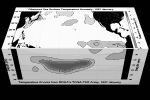| français | Contact Us | Help | Search | Canada Site |
| What's New | Topics | Publications | Weather | Home |
| About Us | ||||
| MSC - EC - GC | ||||
What is La Niña?
Current Status and Forecast
Comparing
La Niñas
Global Effects
Canadian Effects
Further Readings
El Niño
Other Educational Sites
La Niña
Comparing La Niña
Comparison La Niña events, tables listing the years of onset of strong or moderate La Niña and El Niño events, and links to sites containing specific regional information.
Comparisons

|
| [View] (D) |
Multivariate ENSO Index
Eight strongest recorded La Niña.

|
| [View] (D) |
Animated comparison of four La Niña events
Sea surface temperatures in the central and eastern equatorial Pacific.

|
| [View] (D) |
Time series of the MEI during winter

|
| [View] (D) |
A 3-D animation of the water temperatures in the Pacific
basin.
Courtesy of Scripps Institute of Oceanography.

|
| [View] (D) |
Animated comparison of two strongest La Nina events
The 1998 La Niña followed on the heels of the strongest El Niño in over a century. In a matter of 4 weeks, starting in mid-May 1998, water temperatures at the sea surface in the central and eastern Pacific dropped by an unprecedented 9°C. La Niña do not always follow El Niño events, since the early 1970s, the ratio of El Niño to La Nina is 2:1. As of early August 1998, surface temperatures of the Pacific ocean in the central and eastern Pacific are about 3°C below normal. The area occupied by these cold waters slowly expanded and occupied a strip over 7,000 kilometers long. Such La Niña conditions presented climatologists with the best opportunity to produce reliable seasonal predictions.
During the memorable La Niña of 1988-89, the initial cooling rate was much slower. It took two months in 1988 for the Pacific Ocean's surface to chill by 4°C. In 1998, the coldest areas showed a drop in temperatures of twice as much in half the time. A huge reservoir of cold water in the sub layers of the ocean caused the rapid cooling of the surface waters.
El Niño and La Niña Years
1900-1949 —— view data
Classification of El Niño-Southern Oscillation (ENSO) occurrences for the 1900-1949 period. The classification is based on the Southern Oscillation Index (SOI). This index which is used as a measure of ENSO is defined as the standardized air pressure difference between Tahiti and Darwin. ENSO conditions are classified for the winter (December - March) of the years indicated. Significant impact of moderate to strong ENSO events is typically felt during the winter and spring seasons in Canada.
1950-2007 —— view data
Classification of El Niño-Southern Oscillation (ENSO) occurrences for the 1950-2007 period. This classification is based on the magnitude of the sea surface temperatures (SST) in the eastern tropical Pacific Ocean. The SST-based scheme also indicates the strength of the ENSO event. The events are classified for the winter (December - March) season of the years indicated. Significant impact of moderate to strong ENSO events is typically felt during the winter and spring seasons in Canada.
Links
/education/lanina/comparing/index_e.cfm
The Green LaneTM,
Environment Canada's World Wide Web Site.